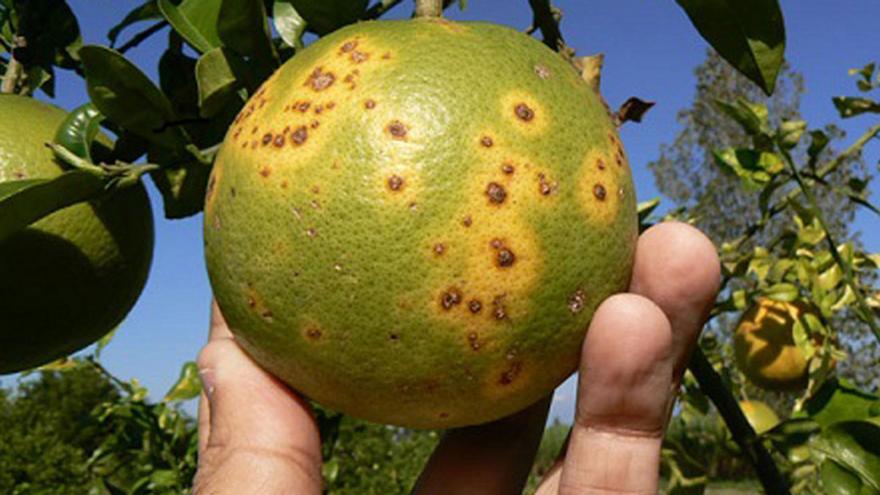
![]() 14ymedio, Havana, November 2, 2021 — Drought, the high costs of cultivation and diseases such as yellow dragon* are all contributing to the decline of citrus production in Jagüey Grande, a town in Matanzas province. “Two years from now, you might not find any here. If someone tells you otherwise, he’s lying,” a resident of the village of Torriente told the state newspaper Granma on Monday.
14ymedio, Havana, November 2, 2021 — Drought, the high costs of cultivation and diseases such as yellow dragon* are all contributing to the decline of citrus production in Jagüey Grande, a town in Matanzas province. “Two years from now, you might not find any here. If someone tells you otherwise, he’s lying,” a resident of the village of Torriente told the state newspaper Granma on Monday.
The article mentions “impoverished plantations and dried-up fields” adding that “nothing remains of the perfectly delineated citrus groves.” A local woman, who together with her husband dedicated most of her life to citrus cultivation, is quoted as saying, “What’s happening is that the citrus is sick and there’s no way to cure it. That’s the simple truth.”
The dearth of financing and investment has had an impact on nation’s citrus crops. At the end of October 2020, the Ministry of Agriculture reported that, of the fields under cultivation, 11,907 hectares were devoted to citrus groves: 3,847 hectares to oranges, 5,439 to grapefruit and 2,000 to limes and lemons. A far cry from the 100,000 hectares planted with citrus trees in 1990.
Lemons now have to practically be beaten before they can be cut and, when squeezed, release little more than a few drops of juice. Market stalls which once featured oranges, grapefruits and mandarins several months a year are now bare or have been restocked with sweet potatoes, chives and cabbages, a sign of the precipitous fall of the citrus sector.
Locals in Jagüey Grande, one of the areas most reliant on citrus production, blame a lack of treatments for the dreaded yellow dragon. “We need financing so we can access the technology and the wide array of chemicals needed to fight this infestation,” admits Michael Gonzalez, deputy director of the Victory of Giron** Agro-Industrial Complex.
In a 2020 report, the Cuban Conflict Observatory warned that the lack of investment has had an impact on citrus production, forcing the country in 2019 to import oranges and limes from Mexico to supply tourist hotels.
Faced with a lack of funding, Farm-Based Business Unit #2 has shifted from its reliance on citrus to other crops such as pumpkin, cucumber, okra, cassava and banana.
This model has also been adopted by the Victory of Giron operation, which has turned to guava, mango, mamey, pineapple and avocado. Gonzalez estimates that production output will soon reach about 50,000 tons, most of it destined for industrial processing.
It seems that enjoying a glass of orange or grapefruit juice in Jagüey Grande will soon be virtually impossible. Producers such as Daniel Oliva now prefer to plant only small areas with citrus fruit to insure higher yields and avoid crop losses from insect infestations and diseases.
Citrus used to be a big deal. In the 1970s and 1980s an extensive citrus-based development plan was put in place on the Isle of Youth, where grapefruit, lemon and orange groves were interspersed with boarding schools attended by students from Latin American, African and Asian countries on scholarships.
This management model spread, offering an alternative to “work-study” programs, but went into decline with the fall of the Soviet bloc. Today, its wide fields are covered in weeds, its buildings abandoned. Now, daily consumption of citrus has become a luxury in Cuban homes.
Translator’s notes:
*Also known as “citrus greening disease,” yellow dragon disease is caused by a bacterial pathogen spread by insects feeding on the fruit.
**What Cubans call “Playa Giron” (Giron Beach), Americans call the “Bay of Pigs.”
____________
COLLABORATE WITH OUR WORK: The 14ymedio team is committed to practicing serious journalism that reflects Cuba’s reality in all its depth. Thank you for joining us on this long journey. We invite you to continue supporting us by becoming a member of 14ymedio now. Together we can continue transforming journalism in Cuba.
